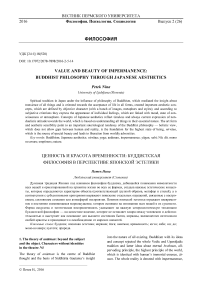Value and beauty of impermanence: Buddhist philosophy through Japanese aesthetics
Автор: Petek Nina
Журнал: Вестник Пермского университета. Философия. Психология. Социология @fsf-vestnik
Рубрика: Философия
Статья в выпуске: 2 (26), 2016 года.
Бесплатный доступ
Spiritual tradition in Japan under the influence of philosophy of Buddhism, which mediated the insight about transience of all things and is oriented towards the acceptance of life in all forms, created important aesthetic con-cepts, which are defined by objective character (with a bunch of images, metaphors and styles); and according to subjective criterions they express the appearance of individual feelings, which are linked with mood, state of con-sciousness or atmosphere. Concepts of Japanese aesthetics reflect timeless and always current expression of non-dualistic attitude towards the world, which is based on understanding all things in their essential nature. The art form and aesthetic sensibility point to an important soteriological tendency of the Buddhist philosophy - holistic view, which does not allow gaps between human and reality, is the foundation for the highest state of being, nirvāṇa, which is the source of special beauty and leads to liberation from worldly adversities.
Buddhism, japanese aesthetics, nirvāṇa, yoga, anātman, impermanence, yūgen, sabi, nō, dō, mono no aware, emptiness, nature
Короткий адрес: https://sciup.org/147203104
IDR: 147203104 | DOI: 10.17072/2078-7898/2016-2-5-14
Список литературы Value and beauty of impermanence: Buddhist philosophy through Japanese aesthetics
- Alland A.Jr. The Construction of Reality and Unreality in Japanese Theatre. The Drama Review. 1979. Vol. 23, no 2, pp. 3-10. (In English).
- Bashō’s haiku: selected poems by Matsuo Bashō/transl. by D.L. Barnhill. Albany: State University of New York Press, 2004. 348 p. (In English).
- Heine S. From Rice Cultivation to Mind Contemplation: The Meaning of Impermanence in Japanese Religion. History of Religions. 1991. Vol. 30, no 4, pp. 373-403. (In English).
- Kato K. Some Notes on Mono no Aware. Journal of the American Oriental Society. 1962. Vol. 82, no 4, pp. 558-559. (In English).
- Keene D. Japanese Aesthetics. Philosophy East and West. 1969. Vol. 19, no 3, pp. 293-306. (In English).
- Kenkō Y. Essays in Idleness: the Tsurezuregusa of Kenkō/transl. by D. Keene. N.Y.: Columbia University Press, 1967. 213 p. (In English).
- LaFleur W.R. Death and Japanese Thought: The Truth and Beauty of Impermanence. Death and Eastern Thought/ed. F.H. Holck. Abingdon: Nashville and New York, 1974, pp.226-256. (In English).
- Lamarque P. Expression and the Mask: The Dissolution of Personality in Noh. The Journal of Aesthetics and Art Criticism. 1989. Vol. 47, no 2, pp. 157-168. (In English).
- Milčinski M. Azijske filozofije in religije . Ljubljana, Mladinska knjiga Publ., 2014, 412 s. (In Slovene).
- Milčinski M. Telo-duh v filozofsko-religijskih tradicijah . Ljubljana, Slovenska matica Publ., 2014. 233 s. (In Slovene).
- Ortolani B. The Japanese Theatre. From Shamanistic Ritual to Contemporary Pluralism. Princeton: Princeton University Press, 1995. 432 p. (In English).
- Pilgrim R.B. The Artistic Way and the Religio-Aesthetic Tradition in Japan. Philosophy East and West. 1977. Vol. 27, no 3, pp. 285-305. (In English).
- Tamura Y. Critique of Original Awakening Thought in Shōshin and Dōgen. Japanese Journal of Religious Studies. 1984. Vol. 11, no 2-3, pp. 243-266. (In English).
- The Dumpling Field. Haiku of Issa/transl. by L. Stryk. Ohio: Ohio University Press, 1991. 133 p. (In English).


